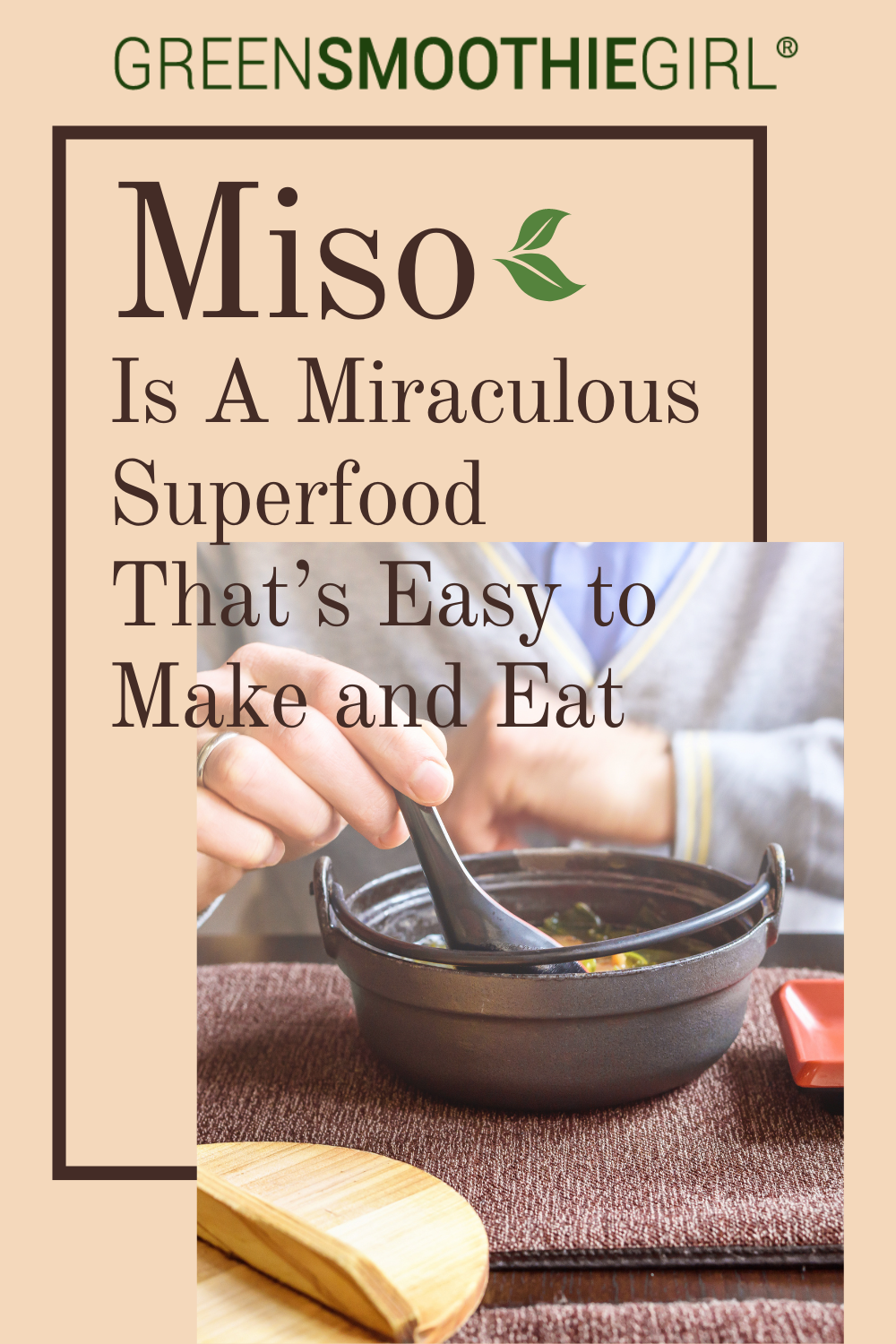Miso Is Miraculous: Discover This Superfood That’s Easy to Make and Eat
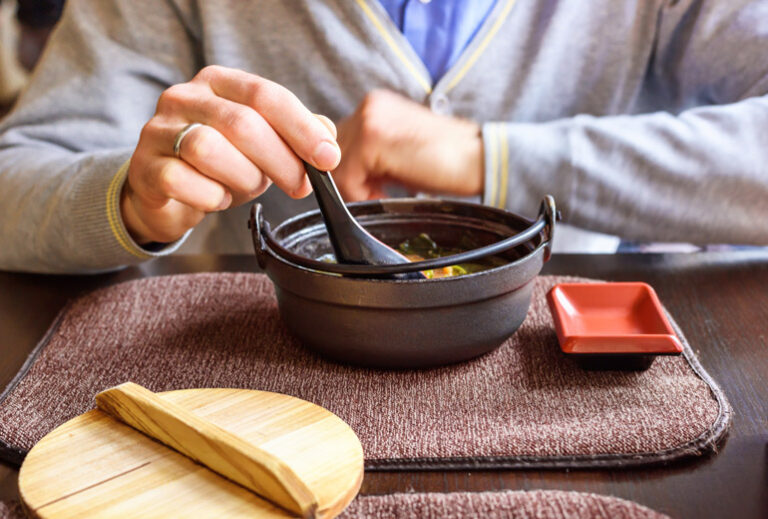
Simple, plant-based foods can be so powerful. I know many of you want to add fermented foods to your diet, for a healthy gut and digestion.
Can we talk about MISO?
Many Japanese eat miso soup every day.
If you eat miso, you always want to buy organic or use ORGANIC soybeans, which you ferment, for the healthy probiotics to populate your gut and keep your immune system strong.
But did you know you can also use chickpeas (garbanzo beans)?
I think when you read this, you’ll want to give miso a try. I just started making it myself, so I wanted to share.
Let’s cover:
What Is Miso?
Miso is a traditional, fermented food with a distinctive savory flavor and a peanut butter-like texture. It keeps well, and it’s a great base for all kinds of soups and much more!
Typically, it’s derived from soybeans and grains. Fermentation improves the digestibility and nutritional value of organic soybeans.
Koji is the “culture” that ferments the soybean or chickpea, to make the miso. The beneficial bacteria are added to a grain, typically rice. It’s similar to kefir grains, which make kefir possible, and it’s also similar to the “mother” in kombucha.

Miso is a traditional Japanese ingredient
Traditionally, there are three types of miso:
- White miso, which is sweeter, uses a higher amount of koji than soybeans, has less salt, and a shorter fermentation time.
- Red miso uses equal amounts of koji to soybeans, with a moderate amount of salt.
- Dark miso has more salt and is fermented for a longer time.
Though soybeans are typically used for miso, other legumes can be used, such as chickpeas.
Miso Is Highly Nutritious
Miso is considered a functional food, providing health benefits beyond meeting nutritional needs. Many researchers recommend eating it daily.1
Miso is typically high in plant protein because it’s made from soybeans or other legumes. Protein is needed by almost every cell in your body.
[Related: Protein Questions and Answers: Myths and Truths]
Miso naturally contains a wide range of vitamins, like vitamin K, vitamin E, and various B vitamins, as well as minerals, like zinc and manganese.
Miso Destroys Anti-Nutrients
Raw soybeans contain anti-nutrients, which bind to essential nutrients and prevent them from being absorbed by our digestive system.
However, the fermentation process of miso destroys the anti-nutrients.
What Are the Health Benefits of Miso?
Miso is an incredibly healthy ingredient to add to your meals. The fermentation process makes it beneficial for your immune system, detoxification, for its anti-cancer properties, for your mood, and more.
Miso Prevents Against the Harmful Effects of Radiation
The earliest health benefit of miso soup was its protection against radiation injury.
When the second atomic bomb devastated Nagasaki in Japan, 21 healthcare workers were attending to 70 patients in a hospital right next to ground zero.
None of them suffered from radiation poisoning. Dr. Tatsuichiro Akizuki attributed this to their daily consumption of miso soup with wakame seaweed.
A comprehensive review confirms the power of miso to prevent radiation injury.2
How Are You Exposed to Radiation?
Radiation comes from man-made sources, such as X-rays, radiation therapy for cancer, and electrical power lines.
Background radiation is also around us all the time.3 Radioactive isotopes are in the ground, soil, water, and our bodies.
Miso Detoxifies the Body
Some studies suggest that miso contains an alkaloid, which helps to detoxify the body and facilitate the removal of heavy metals from the body.
[Related: How To Detox from Heavy Metals Naturally]
Miso Strengthens Immunity
Studies show that miso may help boost the immune system in multiple ways.
Similar to other fermented foods, miso is packed with probiotics. One specific strain of beneficial bacteria found in miso could even alter several types of immune cells, according to a 2018 study.4
Miso for Stomach and Gut Health
Miso has been recognized as one of the top foods for gut health. The Japanese have a proverb that says, eat miso and you won't need to see a doctor – similar to an apple a day keeps the doctor away.
Consuming miso gives you numerous highly active enzymes that aid digestion and absorption of other vital nutrients. The plant fibers it contains help clean the intestines. Additionally, miso has microbes that get rid of harmful bacteria in the intestines and play an important role in decomposing harmful compounds in the body.5
People who consume miso soup daily have a lower risk of developing stomach illnesses, such as ulcers, compared to those who consume it infrequently or never, according to a 2018 population-based study in Japan.6
Additionally, a survey showed a reduced risk of stomach diseases in those who eat miso every day in their 60s and older.7
Miso for Heart Health
People who do not consume miso soup regularly have been found to have higher blood pressure rates in the winter than in any other season.
To minimize the risk of cardiovascular disease, miso should be increased throughout winter, according to 2017 research.8
What about the salt in miso?
Reducing salt intake is a common recommendation for heart health. However, recent studies show that miso actually lessens the effect of salt on blood pressure.9
In one study, two daily servings of miso soup for three months did not affect the blood pressure of subjects with stage 1 hypertension.10
Plus, a community-based study reported that an intake of miso soup is associated with a reduced incidence of cardiovascular disease.11
Miso for Brain Health and Mood
Miso is backed with brain-building compounds, including choline, folate, and B vitamins. Choline also plays a role in your mood.
Miso is also able to raise serotonin levels in the body. Low levels of serotonin are associated with memory loss, depression, and low moods.
Miso May Help Protect Against Cancer
Miso contains a phytochemical that scientists have discovered performs a miraculous feat of cutting off blood flow to cancerous tumors. This incredible process is called anti-angiogenesis – which is thought to be an ideal form of cancer therapy.
A national survey12 in Japan reported that frequent consumption of miso soup reduced the occurrence of breast cancer in women.
Human trials also showed that miso can reduce the risk of gastric cancer13 and liver cancer.14
Miso Is Linked To A Lower Risk of Mortality
A 2020 population-based Japanese study showed that a higher amount of fermented soy products, especially miso and natto, were associated with a lower risk of mortality.15
How To Choose Miso?
When you’re shopping for miso, rather than making it yourself, look for organic, unpasteurized, live, enzyme-rich miso that will need to be stored in the fridge.
This is the type that’s loaded with beneficial microorganisms and has the most health benefits.
How To Make Chickpea Miso
I’m excited to learn about making chickpea miso because I have a bunch of stored chickpeas I’ve been wanting to use.
It only requires three ingredients, and it’s a simple process, with a rich, buttery, slightly sweet flavor. It needs to age for six months, so the hard part is having patience.
Homemade Chickpea Miso Recipe
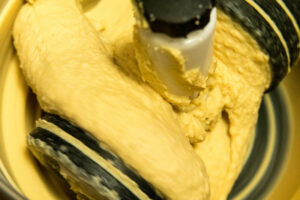
You can make your own miso with chickpeas
This recipe calls for chickpeas. You can also use any pulse to make miso, like organic lentils, black-eyed peas, and soybeans.
Ingredients
18 ounces of organic Chickpeas, soaked overnight (OR 3 15-ounce cans of chickpeas)
18 ounces of organic Koji rice
½ cup coarse Himalayan salt
Directions
Preparation
- If using dry chickpeas, drain the soak water off. Then, add them to a pot, cover them with several inches of water, and bring them to a boil. Reduce the heat and simmer for about 1 ½ to 2 hours. Or, you could cook them in about 18 minutes in an Instant Pot, if you have one. Or, use a slow cooker on high for 3–4 hours, or on low for 6–8 hours. OR, if you’re using canned chickpeas, drain and rinse them well.
- Add 1 cup of water to a small saucepan. Heat over medium heat for 2–3 minutes. Do not let it boil. Remove from heat and let it cool until it reaches about 122°F.
- Add the koji rice to a medium mixing bowl and pour in the warm water. Stir and let it sit for one hour.
Processing
- Transfer the cooked or canned chickpeas, koji (and the water), and salt to a food processor. Process for 1–2 minutes, or until it forms a paste. It should be almost smooth, and all the chickpeas should be puréed. If you have a small food processor, work in batches.
- Prepare two 1-quart glass jars: make sure your jars are perfectly clean. It’s recommended to bake your empty jars at 300°F for 20 minutes to kill possible bacteria, and then let them cool completely.
- Using gloves or clean hands, shape balls of the mixture and pack them very tightly into each jar, working one layer at a time to make sure there are no air holes. Repeat until your jars are 3/4 full.
- Flatten the top of the mixture and sprinkle with about 1/2 tablespoon of salt. Cover with plastic film to touch. Now, you want to place something very heavy inside the jar on top of the miso. It must be heavy enough to prevent the miso from creating air bubbles due to the fermentation.
Aging
- Close your jars with the lid and store them in a dark place at room temperature. Your miso will be ready in 6 months, you don't have to do anything else but wait! Don’t open the jar in the meantime!
- After 6 months, transfer the miso to smaller jars and store them in the fridge.
Note: Rice koji is fermented, steamed rice, which starts the fermentation of your miso. You can buy organic koji rice online, like this organic, brown-rice koji, or you may be able to find it in an Asian grocery store if you have one nearby.
How To Use Miso?
The flavor of miso is complex, making it a unique ingredient to experiment with. Of course, soup is the most common way to enjoy the health benefits of miso.
Basic Miso Soup Recipe
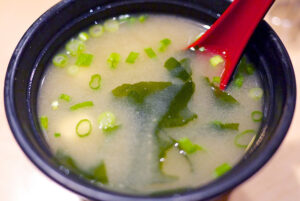
Miso soup is an easy way to enjoy the benefits of miso
Makes 2 servings
Ingredients
1 ½ cups of water
¾- 1 teaspoon of red organic soybean miso, or chickpea miso
2 inches of wakame, torn if needed (OR Nori sheets)
1 cup vegetables, finely chopped (like carrot, onion, cabbage, leek, or shitake mushrooms)
1 teaspoon scallions, finely chopped
Directions
- Place the wakame in a small cup of water to soak until tender (about 5 minutes). Finely slice the wakame and place it in a saucepan with fresh spring water or filtered tap water. Bring to a boil, uncovered, over medium heat.
- When the water is boiling, add the vegetables. Simmer all until tender, about three to five minutes.
- In a mug or small bowl, add the miso paste to a small amount of water and stir until blended. Pour the diluted miso into the lightly simmering broth and cook for five more minutes. Serve garnished with chopped scallion.
Note: Not sure what wakame is? It’s one of the most popular types of edible seaweed, is widely used in Asian cuisine, and is incredibly nutritious. Look for it in the Asian section of the grocery store.
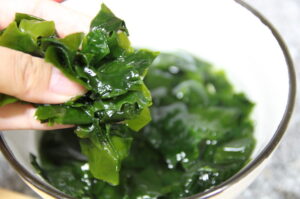
Wakame is a nutritious, edible seaweed
For more health benefits, protein, and a more filling soup, you could add the Natural Unflavored Grass Fed Bone Broth to your soup.
The great thing about miso soup is it has unlimited potential. You could add other ingredients, such as potatoes, spinach, kale, cabbage, bok choy, and noodles.
An Important Note About Cooking with Miso
Miso is a live food that's rich in probiotics. When you cook miso using high heat, the beneficial bacteria and many benefits are destroyed. The beneficial bacteria begin to degrade at 100 degrees F.
So, you don’t want to add miso to boiling water if you want the full benefits. Instead, first, turn off the heat when making soup, and let the miso dissolve by whisking it into the water. You can also mix miso with warm water and then add it to the soup.
You can still use miso as an ingredient when you cook, but you won’t be getting all the benefits unless you’re careful about how you heat it.
More Ways to Use Miso
Additionally, miso is becoming more popular in Western cuisine. It’s used in marinades, dressings, stews, stir-fries, casseroles, dips – and even sweets, like adding a nutty flavor to baked goods. Try it on roasted veggies, like Brussels sprouts or root veggies.
Try miso in salad dressings
I love eating salads as meals. You could make a simple miso dressing by combining about a tablespoon of miso, with a teaspoon of apple cider vinegar, and some water to thin out the miso. You can also add a little high-quality olive oil.
Use miso as a toast topping
And, here’s a simple toast topping. Mash chickpeas, avocado, miso, and lemon juice and spread it on toast or an English muffin.
Use miso in green smoothies
White miso is sweeter, and could even be used in a miso smoothie, along with bananas, cacao powder, spinach, and berries. Our Grass Fed Bone Broth Chocolate flavor and white miso could also be delicious in a smoothie.
In general, the darker the color, the more intense the flavor of the miso. The lighter misos may be better for dressings and sauces, while the darker misos are good for stews and soups.
Will You Eat More Miso to Gain the Miraculous Health Benefits of Miso?
Now that you know the miraculous benefits of miso and how easy it is to eat and even to make, will you add more of it to your meals?
Consuming it as you age and in the winter is especially beneficial. But keep in mind that miso is a complex, intense flavor, so using it in small amounts is best.
Read Next: Are You Scared of Fermented Foods?

Disclosure: This post may contain affiliate links that help support the GSG mission without costing you extra. I recommend only companies and products that I use myself.
Resources
1. Saeed, Farhan et al. “Miso: A traditional nutritious & health-endorsing fermented product.” Food science & nutrition vol. 10,12 4103-4111. 15 Sep. 2022. https://doi.org/10.1002/fsn3.3029
2. Shiraki, Kateuhisa et al. “Inhibition by long-term fermented miso of induction of pulmonary adenocarcinoma by diisopropanolnitrosamine in Wistar rats.” Hiroshima Journal of Medical Sciences, vol. 52,1 (2003): 9-13.
3. https://medlineplus.gov/radiationexposure.html
4. Kumazawa, T., Nishimura, A., Asai, N., & Adachi, T. (2018). Isolation of immune-regulatory Tetragenococcus halophilus from miso. PloS one, 13(12), e0208821. https://doi.org/10.1371/journal.pone.0208821
5. Marco, M.L. et al. (2017). Health benefits of fermented foods: microbiota and beyond. Current Opinion in Biotechnology, Volume 44, p. 94-102. https://doi.org/10.1016/j.copbio.2016.11.010
6. https://www.jstage.jst.go.jp/article/jnsv/64/5/64_367/_article
7. https://www.jstage.jst.go.jp/article/tox/26/2/26_2012-0055/_article
8. Nozue, Miho et al. “Fermented Soy Product Intake Is Inversely Associated with the Development of High Blood Pressure: The Japan Public Health Center-Based Prospective Study.” The Journal of Nutrition, vol. 147,9 (2017): 1749-1756. https://doi.org/10.3945/jn.117.250282
9. Ito, K. Review of the health benefits of habitual consumption of miso soup: focus on the effects on sympathetic nerve activity, blood pressure, and heart rate. Environ Health Prev Med 25, 45 (2020). https://doi.org/10.1186/s12199-020-00883-4
11. Kokubo, Yoshihiro et al. “Association of dietary intake of soy, beans, and isoflavones with risk of cerebral and myocardial infarctions in Japanese populations: the Japan Public Health Center-based (JPHC) study cohort I.” Circulation vol. 116,22 (2007): 2553-62. https://doi.org/10.1161/CIRCULATIONAHA.106.683755
12. Yamamoto, Seiichiro et al. “Soy, isoflavones, and breast cancer risk in Japan.” Journal of the National Cancer Institute vol. 95,12 (2003): 906-13. https://doi.org/10.1093/jnci/95.12.906
13. Hirayama T. (1982). Relationship of soybean paste soup intake to gastric cancer risk. Nutrition and Cancer, 3(4), 223–233. https://doi.org/10.1080/01635588109513726
14. Sharp, Gerald B et al. “Relationship of hepatocellular carcinoma to soya food consumption: a cohort-based, case-control study in Japan.” International journal of Cancer vol. 115,2 (2005): 290-5. https://doi.org/10.1002/ijc.20897
15. Allwood, J. G., Wakeling, L. T., & Bean, D. C. (2021). Fermentation and the microbial community of Japanese koji and miso: A review. Journal of Food Science, 86(6), 2194–2207. https://doi.org/10.1111/1750-3841.15773
Notes about images:
- Miso image is used under a Creative Commons Attribution-Share Alike 3.0 license by Wikimedia Commons
- Miso soup image is used under a Attribution-NonCommercial-ShareAlike 2.0 license by Gyu Kaku
- Chickpea miso image is under a Attribution-ShareAlike 2.0 Generic license by Edsel Little
- Wakame image is used under a Creative Commons Attribution 2.0 license by Wikimedia Commons
Posted in: Health Concerns, Immunity, Natural Products, Whole Food


